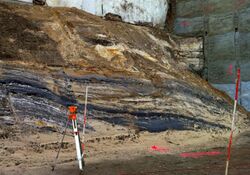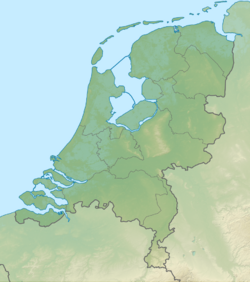Earth:Aachen Formation
| Aachen Formation Stratigraphic range: Santonian-Campanian ~85–71 Ma | |
|---|---|
 The Aachen Formation in Hergenrath | |
| Type | Geological formation |
| Underlies | Vaals Formation |
| Overlies | Limburg Group |
| Lithology | |
| Primary | Sandstone |
| Location | |
| Coordinates | [ ⚑ ] : 50°48′N 5°54′E / 50.8°N 5.9°E |
| Paleocoordinates | [ ⚑ ] 40°48′N 7°18′E / 40.8°N 7.3°E |
| Region | Dutch Limburg, Belgian Limburg, North Rhine-Westphalia |
| Country | Belgium, Germany, Netherlands |
| Type section | |
| Named for | Aachen |
| Region | North Rhine-Westphalia |
| Country | Germany |
The Aachen Formation (Dutch: Formatie van Aken, German: Aachen-Formation) is an Upper Cretaceous geologic formation in the southern Netherlands and northeastern Belgium and adjacent Germany .[1]
It is stratigraphically equivalent to the middle part of the Chalk Group of England, and named after the German city of Aachen.
Geography
The formation crops out in southern Belgian and Dutch Limburg and adjacent areas in Germany . The formation can also be found in the subsurface of West Flanders, where it forms an aquifer from which drinking water is won.
Geology
The Aachen Formation consists of glauconite bearing sand. It was deposited during the Santonian and Campanian ages (85.8 to 70.6 million years ago) of the Cretaceous Period.
The formation rests unconformably on top of Carboniferous rocks of the Limburg Group, which are more than three times as old. Overlying the Aachen Formation is the Vaals Formation, equivalent to the upper part of the Chalk Group of England.
Fossil content
Among others, the following fossils have been reported from the formation:[1]
Corals
- Cunnolites cancellata[2]
Flora
- Pollen
- Chrysotheca dentata[4]
- Chrysotheca quadriplicata[4]
- Chrysotheca striata[4]
- Chrysotheca tenuis[4]
- Geleenites fascinus[4]
- Spherites spinosus[4]
- Triletes aachenensis[4]
- Triletes carbunculus[4]
- Triletes compositi-punctatus[4]
- Triletes cristatus[4]
- Triletes diktyotus[4]
- Triletes dubius[4]
- Triletes lobatus[4]
- Triletes minimus[4]
- Triletes nanus[4]
- Triletes occultatus[5]
- Triletes persimilis[4]
- Triletes pupus[4]
- Triletes tenellus[4]
See also
- List of stratigraphic units in the Netherlands
- List of fossiliferous stratigraphic units in the Netherlands
- List of fossiliferous stratigraphic units in Belgium
- List of fossiliferous stratigraphic units in Germany
References
- ↑ 1.0 1.1 Aachen Formation at Fossilworks.org
- ↑ Leloux, 1999
- ↑ Smets, G. (1888). "Aachenosaurus multidens". Bulletin de la Société belge de géologie, de paléontologie et d'hydrologie (Bruxelles: The society) 12 (2): 300. https://www.biodiversitylibrary.org/item/173327#page/316/mode/1up.
- ↑ 4.00 4.01 4.02 4.03 4.04 4.05 4.06 4.07 4.08 4.09 4.10 4.11 4.12 4.13 4.14 4.15 4.16 4.17 Dijkstra, 1949
- ↑ Dijkstra, 1961
Bibliography
- Leloux, J. 1999. Numerical distribution of Santonian to Danian corals (Scleractinia, Octocorallia) of southern Limburg, the Netherlands. Geologie en Mijnbouw 78. 191–195.
- Batten, D. J. 1988. Revision of S J Dijkstra's Late Cretaceous megaspore and other plant microfossils from Limburg, the Netherlands. In J. W. J. Van Amerom (ed.). Mededelingen Rijks Geologische Dienst 41. 1–55.
- Dijkstra, S. J. 1961. On megaspores, Charophyta fruits and some other small fossils from the Cretaceous. The Palaeobotanist 8. 8–18.
- Dijkstra, S. J. 1949. Megaspores and some other fossils from the Aachenian (Senonian) in South Limburg, Netherlands. Mededelingen Van de Geologische Stichting, Niewe Serie 3. 19–32.
 |


